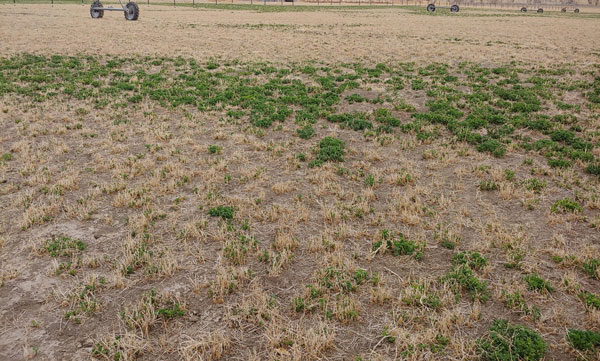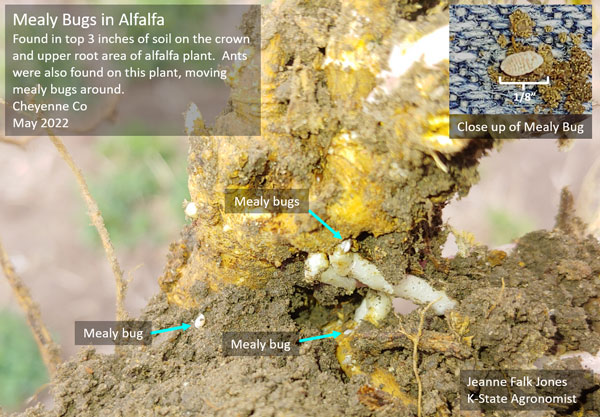First identified in 2008 as a potential pest of soybeans in the United States, trochanter mealybugs (Pseudococcus sp.) have a wide variety of hosts, including corn, sorghum and alfalfa. While their role as a pest of soybeans is still not fully understood, it appears that this mealybug has the potential to be a problem in Kansas alfalfa as sporadic infestations have been detected in the western part of the state, one as recently as 2022 (Figure 1).

Figure 1. Irrigated alfalfa field with a mealybug infestation in 2022. Photo by Jeanne Falk Jones, K-State Research and Extension.
Trochanter mealybugs are small (~2mm) unarmored, scale insects. They are flattened, whitish, and wax-covered and feed on plant roots by removing fluids from the plant with piercing-sucking mouthparts (Figure 2). Due to their small size and life history, they often go undetected.

Figure 2. Mealy bugs in an alfalfa field in Cheyenne County, Kansas in May 2022. Photo by Jeanne Falk Jones, K-State Research and Extension.
When mealybugs are young, they can move short distances from one plant to the next on their own. They are also moved readily in irrigation water as the waxy covering on their bodies helps them survive being submerged. However, these insects tend to move the greatest distances with the help of ants. In fact, increased ant activity in infested fields is often noticed before mealybugs are discovered. The ants are tending the mealybugs to eat the honeydew the bugs excrete and in turn the ants protect them from predators (Figure 3).

Figure 3. Ant tending to a mealybug. Photo by Jeanne Falk Jones, K-State Research and Extension.
Plants infested with these mealybugs typically look like they have a potassium deficiency with yellowed leaf margins, stunted growth, and parts of a field may fail to adequately green up. If fields display these symptoms and they cannot be explained by other factors, plants should be dug up and the roots examined for the presence of these insects. Again, the presence of ants may be a clue and often small, sunken trails on the soil surface can be found that ants are using to move mealybugs around in the field.
There are no thresholds or control measures for this pest. Crop rotation may help, but this pest can survive on several crop and weed species. Attempts to control the ants in a field will not eliminate the mealybug population.
The distribution of these mealybugs in Kansas alfalfa is currently not well understood. If you do find trochanter mealybugs in your fields, please do not hesitate to contact your local extension professionals.
Anthony Zukoff, Entomology Extension Associate – Southwest Research and Extension Center
azukoff@ksu.edu
Jeanne Falk Jones, Multi-County Agronomist – Sunflower District
jfalkjones@ksu.edu